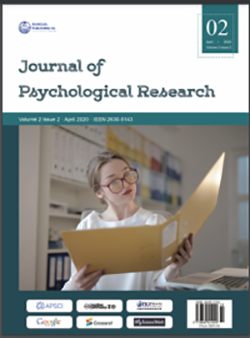-
571
-
345
-
335
-
328
-
299
Bilingualism and Culture: Psycholinguistic Aspect
DOI:
https://doi.org/10.30564/jpr.v2i2.1833Abstract
The development of bilingualism of a bilingual child is inextricably linked with the formation of an individual folklore-linguistic picture of the world. In this regard, proverbs, sayings, riddles and folk phraseology as universal phenomena of folklore of the Russian and Greek languages, which have important linguistic and cultural potential, are of particular interest from the point of view of their presence in the bilingual speech and thought activity.
The quantitative and qualitative characteristics of the functioning of paremiological and phraseological units in a bilingual speech determine the content of folklore language worldview and directly depend on the type of formation of the child’s early bilingualism.
Phraseological and paremiological composition of the folklore picture of the world of natural Russian-Greek bilinguals is asymmetric and directly depends on the type of early bilingualism – in bilinguals who learn two languages on the principle of “one-person-one-language ”, asymmetry prevails in favor of the Greek language, children from Russian-speaking families whose bilingualism develops according to the principle “family language is the language of society ” exhibit better knowledge of Russian folklore elements compared to GreekKeywords:
bilingualism; “one-person-one-language”; “the language of the family is the language of society“; folklore-linguistic picture of the world; linguistic and cultural potentialReferences
[1] Bialystok E. (2001). [M]. Bilingualism in Development: Language, Literacy, and Cognition. Cambridge: Cambridge University Press.
[2] Bloomfield L. (1933). [M]. Language. Chicago: University of Chicago Press.
[3] Cantone K.F., Kupisch T., Müller N., Schmitz K. (2008). [J]. Rethinking language dominance in bilingual children. Linguistische Berichte. 215. PP. 307-343.
[4] Gathercole V.C. Kennedy I., & Thomas E. M. (2016). [J]. Socioeconomic level and bilinguals' performance on language and cognitive measures. •Bilingualism: Language and Cognition. 1:1-22 PP. 1‒22.
[5] Grosjean F. (1992). [J]. Another view of bilingualism. Cognitive Processing in Bilinguals. Vol. 83. PP. 51–62.
[6] Hornby P. (1977). [M]. Bilingualism. Psychological, Social, and Educational Implications. New York: Academic Press.
[7] Kim A., Park A. & Lust B. (2016). [J]. Simultaneous vs. successive bilingualism among preschool-aged children: a study of four-year-old Korean–English bilinguals in the USA. International Journal of Bilingual Education and Bilingualism. https://doi.org/10.1080/13670050.2016.1145186
[8] Pinker S. (1994). [M]. The Language Instinct. New York, NY: Harper Perennial Modern Classics.
[9] Romaine S. (1995). [M]. Bilingualism. UK: Blackwell.
[10] Skutnabb-Kangas T. (1981). [M]. Bilingualism or not: the education of minorities. Clevedon: Multilingual Matters.




 Veronika Viktorovna Katermina
Veronika Viktorovna Katermina





